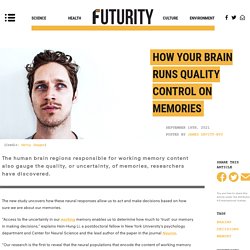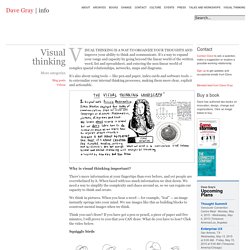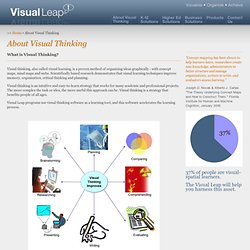

How your brain runs quality control on memories. Share this Article You are free to share this article under the Attribution 4.0 International license.

The human brain regions responsible for working memory content also gauge the quality, or uncertainty, of memories, researchers have discovered. EN IMAGES. Une carte du monde montre les pays à leur "vraie" taille contrairement aux planisphères classiques. Data Visualization. Are You A Visual Thinker? Flickr_images2tag_2 : Built with Processing. For all who ❤ color. Visualization Tools. Easel.ly. Visual Thinking. Visual thinking basics. Time on the Brain: How You Are Always Living In the Past, and Other Quirks of Perception. I always knew we humans have a rather tenuous grip on the concept of time, but I never realized quite how tenuous it was until a couple of weeks ago, when I attended a conference on the nature of time organized by the Foundational Questions Institute.

This meeting, even more than FQXi’s previous efforts, was a mashup of different disciplines: fundamental physics, philosophy, neuroscience, complexity theory. Crossing academic disciplines may be overrated, as physicist-blogger Sabine Hossenfelder has pointed out, but it sure is fun. Like Sabine, I spend my days thinking about planets, dark matter, black holes—they have become mundane to me. But brains—now there’s something exotic. So I sat rapt during the neuroscientists’ talks as they described how our minds perceive the past, present, and future. McDermott outlined the case of Patient K.C., who has even worse amnesia than the better-known H.M. on whom the film Memento was based.
How can I improve my short term memory? Q: How can I improve my memory?

Is there a daily exercise I can do to improve it? A: The most important component of memory is attention. By choosing to attend to something and focus on it, you create a personal interaction with it, which gives it personal meaning, making it easier to remember. Elaboration and repetition are the most common ways of creating that personal interaction. Elaboration involves creating a rich context for the experience by adding together visual, auditory, and other information about the fact. One common technique used by students, is actually, not that helpful. These techniques do help you improve your memory on a behavioral level, but not on a fundamental brain structure level.
60 Small Ways to Improve Your Life in the Next 100 Days. Contrary to popular belief, you don’t have to make drastic changes in order to notice an improvement in the quality of your life.

At the same time, you don’t need to wait a long time in order to see the measurable results that come from taking positive action. All you have to do is take small steps, and take them consistently, for a period of 100 days. Below you’ll find 60 small ways to improve all areas of your life in the next 100 days. Think faster focus better and remember moreRewiring our brain to stay younger...
Identify a Lie with 6 Simple Questions. Post written by: Marc Chernoff Email We all fall victim to at least a few lies during the course of our lifetime.

Some lies may be extremely troublesome to our personal wellbeing, while other “white lies” may be far more innocuous. Either way, a lie is meant to deceive. Today Is Your Day To Win. Visual thinking school. Visual thinking is a way to organize your thoughts and improve your ability to think and communicate.

It’s a way to expand your range and capacity by going beyond the linear world of the written word, list and spreadsheet, and entering the non-linear world of complex spacial relationships, networks, maps and diagrams. It’s also about using tools — like pen and paper, index cards and software tools — to externalize your internal thinking processes, making them more clear, explicit and actionable. Why is visual thinking important? There’s more information at your fingertips than ever before, and yet people are overwhelmed by it. When faced with too much information we shut down. We think in pictures. Data Visualizations, Challenges, Community. Commercial tools. Visual Thinking.
Home - Visual Thinking Strategies. The Visual Leap - About Visual Thinking. >> Home • About Visual Thinking About Visual Thinking Visual thinking, also called visual learning, is a proven method of organizing ideas graphically - with concept maps, mind maps and webs.

Scientifically based research demonstrates that visual learning techniques improve memory, organization, critical thinking and planning. Visual thinking is an intuitive and easy-to-learn strategy that works for many academic and professional projects. The more complex the task or idea, the more useful this approach can be. Visual Leap programs use visual thinking software as a learning tool, and this software accelerates the learning process. According to studies conducted by the Institute for the Advancement of Research in Education, visual learning techniques improve: Test scores Writing Proficiency Long-term Retention Reading Comprehension Thinking and Learning Skills. 100+ Awesome Open Courseware Links for Artists. Posted by Site Administrator in Learning Tools Nov 20th, 2008 By Kelsey Allen Whether you’re into art theory, studying ancient art or making art yourself, you can find a range of online courses and lectures that can help educate you on your field of interest.

Check out these open courseware resources to learn more, get fresh perspectives and expand your artistic horizons. Introductory Courses Learn the basics from these courses geared towards the beginner. Introduction to Sculpture : This course will deal with issues central to modern sculpture like site, context, process, psychology and aesthetics as well as helping students to work with some more non-traditional materials.
Images and Online Exhibits. Create an Explosive Cover with Precise Photo Manipulation Techniques. Web Data Mining - An Introduction. Mind Maps/Thinking Maps/Graphic Organizers. Mind mapping. Infographs. Data Visualization.
Data/Information. .bodycard 1300.